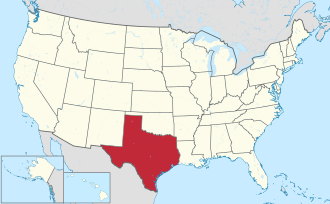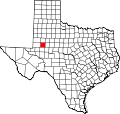Demographics
Historical population| Census | Pop. | Note | %± |
|---|
| 1880 | 12 | | — |
|---|
| 1890 | 264 | | 2,100.0% |
|---|
| 1900 | 332 | | 25.8% |
|---|
| 1910 | 1,549 | | 366.6% |
|---|
| 1920 | 1,146 | | −26.0% |
|---|
| 1930 | 5,785 | | 404.8% |
|---|
| 1940 | 5,556 | | −4.0% |
|---|
| 1950 | 5,541 | | −0.3% |
|---|
| 1960 | 5,068 | | −8.5% |
|---|
| 1970 | 4,774 | | −5.8% |
|---|
| 1980 | 4,684 | | −1.9% |
|---|
| 1990 | 4,956 | | 5.8% |
|---|
| 2000 | 4,746 | | −4.2% |
|---|
| 2010 | 4,799 | | 1.1% |
|---|
| 2020 | 5,237 | | 9.1% |
|---|
|
Martin County, Texas – Racial and ethnic composition
Note: the US Census treats Hispanic/Latino as an ethnic category. This table excludes Latinos from the racial categories and assigns them to a separate category. Hispanics/Latinos may be of any race.| Race / Ethnicity (NH = Non-Hispanic) | Pop 2000 [11] | Pop 2010 [9] | Pop 2020 [10] | % 2000 | % 2010 | % 2020 |
|---|
| White alone (NH) | 2,696 | 2,578 | 2,780 | 56.81% | 53.72% | 53.08% |
| Black or African American alone (NH) | 74 | 67 | 81 | 1.56% | 1.40% | 1.55% |
| Native American or Alaska Native alone (NH) | 8 | 15 | 22 | 0.17% | 0.31% | 0.42% |
| Asian alone (NH) | 8 | 11 | 9 | 0.17% | 0.23% | 0.17% |
| Pacific Islander alone (NH) | 0 | 3 | 1 | 0.00% | 0.06% | 0.02% |
| Other race alone (NH) | 0 | 7 | 19 | 0.00% | 0.15% | 0.36% |
| Mixed race or Multiracial (NH) | 35 | 32 | 70 | 0.74% | 0.67% | 1.34% |
| Hispanic or Latino (any race) | 1,925 | 2,086 | 2,255 | 40.56% | 43.47% | 43.06% |
| Total | 4,746 | 4,799 | 5,237 | 100.00% | 100.00% | 100.00% |
As of the census [12] of 2000, there were 4,746 people, 1,624 households, and 1,256 families residing in the county. The population density was 5 people per square mile (1.9 people/km2). There were 1,894 housing units at an average density of 2 units per square mile (0.77/km2). The racial makeup of the county was 79.01% White, 1.58% Black or African American, 0.82% Native American, 0.17% Asian, 16.06% from other races, and 2.36% from two or more races. 40.56% of the population were Hispanic or Latino of any race.
There were 1,624 households, out of which 42.70% had children under the age of 18 living with them, 64.30% were married couples living together, 9.50% had a female householder with no husband present, and 22.60% were non-families. 21.70% of all households were made up of individuals, and 11.80% had someone living alone who was 65 years of age or older. The average household size was 2.87 and the average family size was 3.36.
In the county, 33.90% of the population was under the age of 18, 6.70% was from 18 to 24, 26.40% from 25 to 44, 19.70% from 45 to 64, and 13.30% was 65 years of age or older. The median age was 32 years. For every 100 females there were 95.60 males. For every 100 females age 18 and over, there were 92.70 males.
The median income for a household in the county was $31,836, and the median income for a family was $35,965. Males had a median income of $29,360 versus $19,063 for females. The per capita income for the county was $15,647. About 14.90% of families and 18.70% of the population were below the poverty line, including 23.90% of those under age 18 and 17.10% of those age 65 or over.
Government and politics
Government
Martin County, like all counties in Texas, is governed by a commissioners' court. This court consists of the county judge (the chairperson of the court), who is elected county-wide, and four commissioners who are elected by the voters in each of four precincts.
The Commissioners' Court is the policy-making body for the county; in addition, the county judge is the senior executive and administrative position in the county. The Commissioners' Court sets the county tax rate, adopts the budget, appoints boards and commissions, approves grants and personnel actions, and oversees the administration of county government. Martin County is one of only a few Texas counties where the county and district clerks have been combined into one position.
Martin County is represented in the United States Congress as part of Texas's 19th congressional district, represented by Republican Jodey Arrington of Lubbock. Its two senators are Ted Cruz and John Cornyn, both Republicans. At the state level, Limestone County is represented in the Texas State Legislature as part of Texas's 82nd House of Representatives district, represented by Republican Tom Craddick of Midland, and Texas Senate, District 31, represented by Republican Kevin Sparks of Midland.
County Commissioners
| Office [13] | Name | Party |
|---|
| | County Judge | Bryan Cox | Republican |
| | Commissioner, Precinct 1 | Kenny Stewart | Republican |
| | Commissioner, Precinct 2 | Auggie Ramos | Republican |
| | Commissioner, Precinct 3 | Brian Snellgrove | Republican |
| | Commissioner, Precinct 4 | Koy Blocker | Republican |
County Officials
| Office [13] | Name | Party |
|---|
| | District/County Attorney | James Napper | Republican |
| | County/District Clerk | Linda Gonzalez | Republican |
| | Sheriff | Randy Cozart | Republican |
| | Tax Assessor-Collector | Lori Pardue | Republican |
| | Treasurer | Cynthia O'Donnell | Republican |
Politics
Martin County, like most other Southern counties, was once deeply Democratic. It continuously gave over 70% of the vote to the Democratic candidate, and only voted twice for Republicans (both during national landslides) between statehood and 1980, after which it swung sharply to the right. Since then, it has followed the rest of West Texas in becoming one of the most loyally Republican areas in the state and has only swung further towards Republicans in the 21st century due to the rapidly liberalizing social policies of the Democratic Party as well as concerns over Democratic climate policy, which is considered unattractive by West Texans due to their predominantly fossil-fuel production based economy. [14] In 2024, Republican Donald Trump received 87.6% of the vote, the best a Republican has ever received in the county.
Until November 2018, Martin County was one of six [15] entirely dry counties in Texas. During that month, Martin County changed from a dry county to a partially wet [16] county after Stanton residents voted to approve the sale of beer and wine within city limits. [17] Five dry counties remain. [18] [19]
This page is based on this
Wikipedia article Text is available under the
CC BY-SA 4.0 license; additional terms may apply.
Images, videos and audio are available under their respective licenses.




